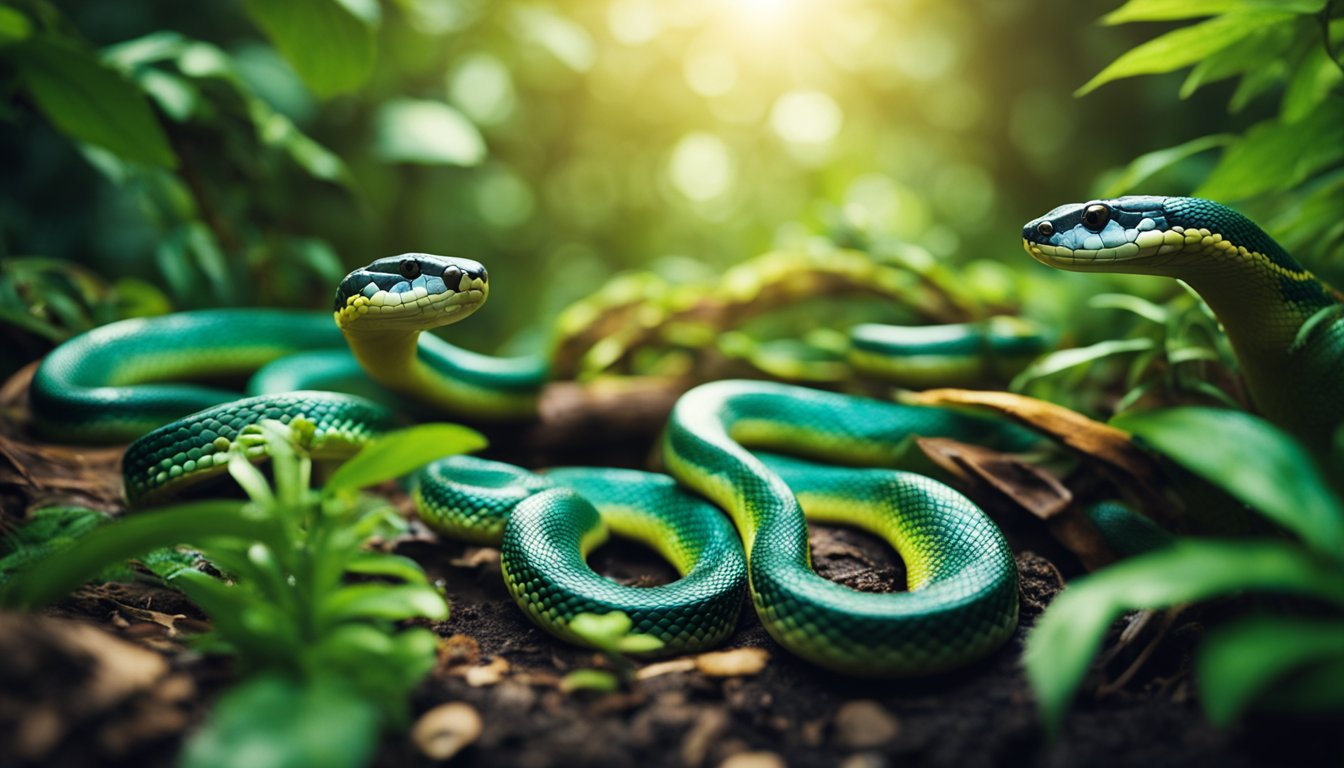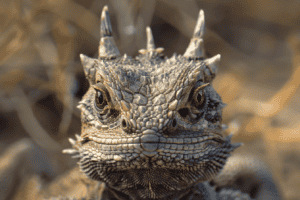Snakes may often be misunderstood, but they’re truly fascinating creatures crucial to our planet’s rich biodiversity.
Imagine legless animals that can glide across the land, swim in water, and even hoist themselves up trees—snakes do it all.
From the tiny thread snake that could easily curl up on a quarter to the enormous reticulated python stretching longer than a limousine, these reptiles come in all sizes and display a myriad of behaviors that can both amaze and educate us.

Curious kids might wonder how snakes eat without hands or why they shed their skin.
Well, these slithering reptiles have a jaw that can stretch wide to gobble prey much larger than their head, and they must shed their skin to grow, revealing a shiny new layer every time.
Snakes play a pivotal role in controlling pest populations and are an integral part of many indigenous cultures’ myths and legends.
With over 3,000 species slinking around our world, there’s so much to learn about these scaly friends.
They’ve been around for millions of years, adapting to almost every corner of the globe.
Some snakes wield venom, a potent concoction that can protect them from predators or help them to subdue their next meal.
Yet, despite their sometimes fearsome reputation, snakes are more interested in steering clear of humans than confronting them.
Through exploring these 10 slithery facts, kids will gain a new perspective on these creatures, understanding their importance in nature’s grand tapestry.
Exploring the Diversity of Snakes
Snakes are an incredibly varied group of reptiles, with over 3,000 species slithering through a wide range of habitats around the globe.
These creatures come in a fascinating array of colors and patterns, each uniquely suited to their environment.
Species and Habitats
Snakes can be found on every continent except Antarctica, illustrating their remarkable adaptability.
From the steamy rainforests of the Amazon to the harsh deserts of Africa, these reptiles have carved out a niche in virtually every ecosystem.
Consider the fierce anaconda, lurking beneath the murky waters of South American rivers, or the swift sidewinder moving across the sandy dunes of the Sahara with its distinctive locomotion.
Each species has evolved specialized skills and physical attributes that allow them to thrive in their respective homes.
One might encounter the vibrant Green Tree Python perched elegantly in the canopies of Australia and Papua New Guinea, blending in with the leaves while waiting for an unsuspecting prey.
Another species, the King Cobra—the world’s longest venomous snake—commands respect in the forests of Southeast Asia with its imposing presence and intelligence.
Colors and Patterns
The assortment of colors and patterns on snakes is not only beautiful but also serves crucial survival functions.
Patterns can camouflage a snake within its environment, protect it from predators, or even help it to attract a mate.
The bold, alternating bands of the Coral Snake serve as a warning signal to potential predators, signaling the potent venom it carries.
In contrast, the Gaboon Viper sports a complex, leaf-like pattern on its body, making it nearly invisible against the forest floor litter where it awaits prey.
Children might be delighted to know that while many snakes wear a fixed pattern throughout their lives, others can change their colors.
Take, for instance, the North American Copperhead, which can display a range of color variations from pink to coppery brown, enabling it to blend into different surroundings seasonally.
It’s a scaly spectacle of nature’s artistry at its finest.
With these riveting facts about snakes’ diverse species, habitats, colors, and patterns, one can truly appreciate the complexity and beauty of these fascinating reptiles.
Whether they’re blending into the background or standing out in stark contrast, snakes are masterful survivors in the wild.
The Anatomy of a Snake

Snakes are fascinating creatures with a unique set of anatomical features that allow them to slither, sense, and survive in diverse environments.
From their distinctive scale structure to their remarkable sensory abilities, these aspects of snake anatomy allow them to be the intriguing reptiles kids are so curious about.
Scale Structure
The skin of a snake is covered in scales, which protect its body and help in locomotion.
These scales are made of keratin, the same material that human nails and hair are composed of.
Snakes regularly shed their skin to allow for growth and to remove parasites.
Each scale is shaped to overlap the one behind it, forming a tight seal that keeps dirt and moisture out, and body fluids in.
An interesting feature about these scales is that on their bellies, they are broader and have a special texture that helps them grip the surface as they glide along.
Snake Senses
Snakes have a set of sensory tools that are quite different from our own. Can you imagine flicking your tongue to taste the air?
That’s how snakes smell!
They collect scent particles on their forked tongues and pass them to a specialized organ in their mouth called the Jacobson’s organ.
This helps them detect prey or predators even at a distance.
Their eyes don’t have eyelids and can’t move, but they do provide a wide field of vision.
And for those who wonder how snakes hear without external ears, they actually sense vibrations through their jawbone directly to their inner ear.
Now, isn’t that a clever adaptation for an animal that spends so much time on the ground?
The Diet of Snakes

Snakes have unique diets and hunting techniques that are fascinating to discover.
Exploring these slithery creatures’ eating habits sheds light on the complex ways they have adapted to their environments.
Hunting Techniques
Snakes employ a variety of methods to capture their prey.
They can be stealthy ambush predators, waiting patiently for hours or even days for the right moment to strike.
For example, the python can remain motionless in a forest, blending in with its surroundings until an unsuspecting animal comes close enough.
Some snakes, like the king cobra, are more active hunters that will actively search out and chase down their prey.
Many snakes have specialized senses, such as heat-sensing pits, that allow them to detect warm-blooded animals in pitch darkness.
They use their forked tongues to “taste” the air for scent particles and zone in on potential meals.
What Snakes Eat
Different species of snakes have varied diets based on their size, habitat, and physical capabilities.
The smaller garter snake enjoys a meal of earthworms or amphibians, while the larger anaconda can swallow a whole capybara or even a caiman.
Snakes are carnivores, which means their diet consists solely of other animals. The common foods they consume include:
- Rodents like mice and rats
- Eggs from birds and reptiles
- Insects and arachnids
- Fish and frogs in aquatic environments
- Larger prey including pigs and deer, in case of big constrictor snakes
Their swallowing mechanism is incredibly adapted; they can consume prey several times wider than their heads thanks to their elastic jaws.
Did you know that after a large meal, some snakes can go weeks or even months without eating again? That’s an incredible adaptation for survival!
Snakes in Ecosystems and Human Culture

Snakes hold a unique dual significance as key players in their natural habitats and powerful symbols in human culture.
They can be both fascinating and a bit mysterious!
Role in the Ecosystem
In the tapestry of the ecosystem, snakes play the role of both predator and prey.
With their keen senses, they hunt for rodents, insects, and even other snakes, keeping those populations in check.
It’s kind of like they’re the secret agents of the wild, sneaking around ensuring balance is maintained.
On the flip side, they are a source of food for larger predators such as birds of prey and larger mammals.
Some snakes have a special role in helping control agricultural pests, which makes them indirect allies to farmers.
Imagine a snake as a natural pest controller in a field of crops—it helps farmers save their harvest without using harsh chemicals.
Snakes in Mythology and History
Throughout history, snakes have slithered their way into various myths and legends.
In many cultures, they’re seen as symbols of life, death, and rebirth, due to their skin-shedding that reveals a shiny new layer.
For instance, in ancient Greek culture, Asclepius, the god of medicine, is often depicted with a snake-entwined staff, which today has become a symbol for medicine and healing.
That same snakey staff you might see on a doctor’s badge has been around for thousands of years!
In other tales, snakes can be seen both as wise protectors guarding treasures or as cunning creatures that outsmart heroes and gods.
They’ve been admired and feared, which shows just how big of an impact they have had on human imagination and beliefs.
Frequently Asked Questions

Discover the answers to some of the most fascinating questions about snakes.
These slithery creatures never cease to amaze with their unique adaptations and abilities.
How do snakes move without any legs?
Snakes glide along the ground with remarkable grace, and it’s all thanks to their specialized bellies and powerful muscles.
They contract and expand their muscles in a coordinated sequence, creating waves of motion that push against the ground or any other surface they’re moving over.
Can you tell me why snakes stick out their tongues so often?
Have you ever seen a snake flick its tongue in and out? They’re actually catching tiny particles from the air and ground.
By bringing their tongue back into their mouth and touching it to an organ on the roof, called the Jacobson’s organ, they can “taste” the air, helping them track their prey or navigate around their environment.
What’s the secret behind a snake’s ability to swallow food bigger than its head?
Imagine being able to eat a whole watermelon in one bite!
Snakes can swallow prey that’s much larger than their head because they have incredibly flexible jaws.
Their lower jaws are not fused together at the front like ours, so they can move each side independently while stretchy skin and ligaments let their mouth open wide.
Why do some snakes have venom, and what does it do?
Venom is a survival tool. Some snakes have venom glands that produce toxins, which they inject through their fangs.
This is used either to subdue their prey or as a defense mechanism.
The venom can have different effects, like stopping a prey’s heart or digestion system, making it easier for the snake to consume them.
How can snakes sense their environment without ears?
Who needs ears when you have such a keen sense of vibration?
Snakes may not hear tunes the way we do, but they are great at feeling vibrations through the ground.
These vibrations give them clues about what is happening around them, alerting them to the presence of prey or predators.
What are the different ways snakes can camouflage themselves in the wild?
Snakes are the hide and seek champions of the wild.
They can have patterns that mirror the leaves and shadows of the forest floor, or match the color of the desert sands.
Some might even change their skin color slightly to blend in better with their surroundings, making them nearly invisible to both prey and predators.









